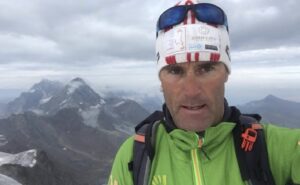Traverse or double-header, doing either Everest or Lhotse without oxygen is difficult and getting rarer. Doing both would be exceptional.
With winter K2 done and dusted, the next “great last unsolved problem” in the Himalaya is probably the Everest-Lhotse traverse. It was a matter of time for it to appear on the radar of the current mountain and social media rock stars. The question is: What exactly is the Everest-Lhotse traverse?
Before we get to that, Colin O’Brady is on his way to attempt one version of that challenge. Remarkably, he will try without supplementary O2.
The American adventurer, who did well on winter K2 despite turning back from Camp 3, says he wants to pay tribute to those who lost their lives on K2 in January and February, especially Juan Pablo Mohr. “He encouraged me to try this no-O2 traverse,” O’Brady said.
Mohr was, in fact, one of only two people to summit Everest without O2 during the crowded 2019 season. He summited just six days after he had also reached the top of Lhotse without O2, together with the late Sergi Mingote. Mingote died in a fall on K2 in January, Mohr a month later.

Colin O’Brady at Camp 3 on K2. Photo: Colin O’Brady
Traverse or double-header?
O’Brady intends to complete the double-header “in a continuous push without using supplemental oxygen.” It is likely that he plans to return to Camp 3, common to both mountains, for a rest between the two summit pushes, rather than complete the “pure” Lhotse-Everest traverse as attempted by Denis Urubko-Simone Moro and Tenji Sherpa-John Griffith.
The slightly easier “direct” Everest-Lhotse double-header with only a rest in Camp 3 was precisely what Sergi Mingote and Juan Pablo Mohr attempted in 2019. Mingote and Mohr remained faithful to their no-O2 style, but while descending from Lhotse, they helped rescue a stricken climber. After this extra effort, they decided to return to Camp 2. A couple of days later, they headed back up Everest. Mingote eventually turned around, while Mohr continued to the summit.

Ueli Steck planned to complete the Everest-Lhotse traverse via Everest’s West Ridge and the Hornbein Couloir but died while preparing for the feat on Nuptse. Map: Ueli Steck via Alan Arnette
By comparison, the pure traverse involves one single push from summit to summit following the summit ridge and not descending further than the South Col. (Many climbers believe that a true traverse always goes along the highest possible points.) Simone Moro and Anatoly Boukreev made the first attempt in 1997. They summited Lhotse but then aborted because Boukreev was tired after guiding clients on Everest.
It remains undone and is among the greatest challenges left in high-altitude alpinism. Simone Moro and Denis Urubko attempted it twice from Nepal. In 2010, Urubko pioneered the Lhotse half of the route, solo from the South Col without oxygen, but did not attempt Everest before or after.
In 2017, Ueli Steck and Tenji Sherpa planned to start from Tibet and then traverse to Lhotse and descend to Base Camp on the Nepal side. Before they could try, Steck perished on Nuptse. A year later, Tenji Sherpa attempted the traverse again with John Griffith. They summited Everest in deteriorating weather and did not try for Lhotse. In the same season, Peter Hamor and Horia Colibasanu (currently attempting Dhaulagiri’s NW Ridge) also launched an attempt from the West Ridge.
In Nepal with friends and family from K2
O’Brady and his wife Jenna Beshaw landed in Kathmandu today. The couple had intended to climb Everest together in 2020 from the Tibet side, but COVID last year and the Chinese authorities’ closure of the north side of Everest this year has forced a change of plans. Besaw will not attempt the summit, and O’Brady is going from the Nepal side.
“Jenna really wanted to climb from the Chinese side but given the change of location and processing the recent tragedy on K2, she has decided to not make a summit attempt on Everest this year,” O’Brady explained.
She will, however, climb up to Camp 2 and follow her husband from there and from Base Camp. Jon Kedrowski, O’Brady’s partner on K2 last winter, will be also there and take on Everest with partner Mike Posner, according to O’Brady.

After winter K2, above, O’Brady (left) will travel with his wife Jenna Beshaw and friends Jon Kedrowski and Mike Posner to Everest. Photo: Jon Kedrowski
Everything O’Brady attempts is meant to be some kind of record. He previously summited Everest in 2016 from Nepal using oxygen, as part of an “Explorers Grand Slam and Seven Summits world record project”. Namely, the Everest+Sp+NP trio.
However, on that occasion, O’Brady skied only the last degree to the Poles, when the genuine Grand Slam requires complete trips from sea to Pole. Later on, his claims for an Antarctica crossing were heavily disputed by the entire polar expedition community. While his projects are difficult, he unfortunately insists on using language in a lawyerly way to suggest that he’s doing something harder and grander than what it is.
O’Brady says he had always been curious to return to Everest and test himself without supplemental oxygen. “Only about two percent of successful summits have been accomplished without O2,” he correctly points out.
Everest summit attempts without oxygen are actually becoming scarcer every year. In addition to the intrinsic difficulties of extreme altitude, the crowding on Everest’s upper slopes in good weather creates hours-long waits to reach the summit, which is difficult for everyone but particularly hard for those without O2. O’Brady himself will have to deal with that problem or plan for a different summit day than the great bulk of oxygen-supplied climbers, as Mingote and Mohr did on their own traverse attempt. Despite uncertainty over COVID, rules, etc., Everest will be almost as crowded as ever this spring.






